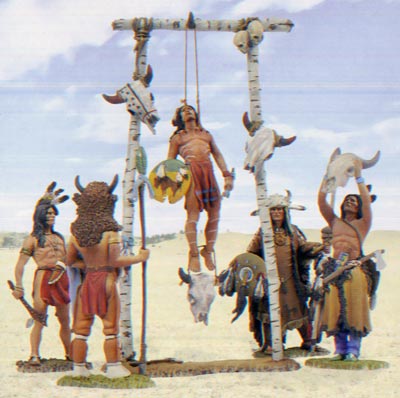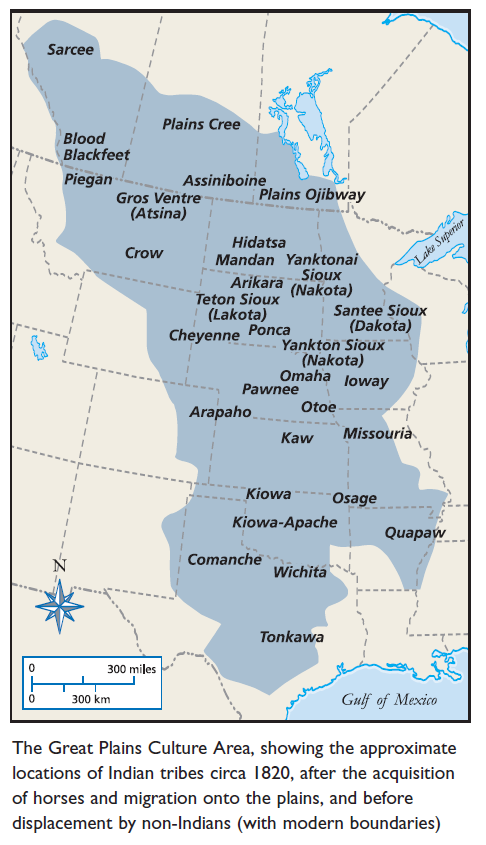Dodge Takes on the "Graveyard of Generals"
By late 1864 Dodge was back in the West, ordered to St. Louis to assume the military command there from General Rosecrans for the state of Missouri, only soon thereafter to be appointed military commander for the territories of Nebraska, Colorado, Utah, Wyoming, and Montana... plus one other state also on the list, Kansas(as in "bleeding Kansas"). Kansas had such a notorious history of pandemic violence going back to before the Civil War that it contributed as a significant cause for the war on its own. Things were still little different there. Or in Missouri, which had been a career-killer for its previous five military commanders.
All together, this vast tract of the American West, though mostly empty, nevertheless contained all the overland links to California and the Pacific: by stage, wagon train, mail or telegraph. Of more interest to Dodge would be the prospect of an adding the railroad link, where four territories out this list eventually provided the right of way access for the future Transcontinental: Nebraska, Wyoming, Utah, and on its periphery, Colorado. So, what the prior commanders saw as a temporary assignment, Dodge must have seen as a permanent base of operations in need of drastic sorting out for building the Transcontinental. And so, Dodge had to come up with yet another new policy somehow to do this.
Overall, it should not have surprised Dodge that things had seriously deteriorated since his departure for war. The Indians of the Great Plains, the Pawnee, the Omahas, Arapahoes, the Cheyennes, Crow, and especially Sioux, all together posed another major source of threat, potential or otherwise. From a nation-builder's perspective like Dodge's, it little mattered which kind the threat was. It must somehow be dealt with. Most Indians saw eastern migration as predatory, having witnessed the stealing of their game, the disease by contact, followed by and eventually corrupting their culture and expropriating their land.

Plains Indian Rite of Passage
Plains Indians like the Lakota Sioux and the Crow were seasoned in the art of war even before the advent of settlers from the East like Dodge. Becoming expert horsemen with the advent of horses in the seventeenth century descendent from the conquistadors, their cultures must have been totally revitalized from their previous marginal circumstances. And their lifestyles took on a totally different temperament. Many such Plains Indian cultures were far from being peaceful hunter-gatherer societies. All of which was not unusual for other cultures in the world dependent on mobile wealth, albeit horses, camels, sheep, cattle, buffalo, or money.
Such disregard for life and limb could take place even within the tribe. Take for example, the Lakota and Crow rite of passage for males, which involved a vision-quest through being crucified and staked out for days in order to hallucinate contact with the spirit world. In another, less unusual but more pervasive rite of passage, mounted teenage raiding parties were dispatched from the tribe to prey on others.
In dealing with this complex of daunting crises, Dodge's policy had to rely initially on limited resources and start from scratch to reestablish some kind of order. The Civil War after all was still going on. What Federal troops he commanded were supplemented by paramilitary police he recruited from loyal elements in the state, many of them refugees holed up in St. Louis
First off, the civilian population had to be sorted out to achieve order. "Bushwackers" and other predators were to be routed out. This included any 'rebels' deemed as 'sympathizers', especially those leaving Price's Confederates, who were raiding throughout Missouri only a few months' before. Many since were returning to their families and were seen as coming home to settle old family scores. Thus, Dodge saw not only them, but also their families as a threat to be dealt with. Dodge sought and got approval from Washington to banish all such from districts still under threat. Perhaps no greater compliment could have been paid to Dodge on the effectiveness of these measures in Missouri than an attempted assassination on his life near the end of his tenure as military governor. The bullet missed, killing his Black driver sitting beside. Dodge then went on to command the five other territories and Kansas as well.

Next came reestablishing at least one important link overland. The route from Fort Leavenworth and Omaha along the South Platte was selected, having once a stage station about every twelve miles all the way across the continent. This was a vital, ongoing source of supply for mines throughout the west. It included Denver and Julesburg. It proved to be this route would be mostly followed by the Union Pacific later on.
To get things started for protecting the stage route, Dodge decided took on more personal risk by "showing the flag. Troops refusing to march with him to reestablish the route were replaced, and their officers put under arrest. In one extreme instance, this occurred in sub-zero weather on the Plains and resulted with deaths due to exposure. Once such 'kick-ass' measures were demonstrated, the word would and inevitably did get around.
Finally, it was the Indian's turn. First action struck at the root of the problem and involved the united Indian uprising over the Chivington massacre near Julesburg. During the Civil War most of the military were removed from the Plains and what remained in this region were mostly kept to base. The civilians, due to their mixed allegiances, had to concern themselves more about threat from their immediate neighbors than from the Indians. So perhaps not surprisingly, aggression with Indians seemed smaller in number, scale, and intensity.
But, with the Chivington massacre of November, 1864, things had taken a sudden drastic lurch beyond any and all available means of control. The Reverend Chivington had organized his own militia out of irregulars mostly from Julesburg, Colorado. He appointed himself Colonel as its commander. With the fever of a Crusader Chivington set forth, "to kill Indians, and (I) believe it is right and honorable to use any means under God's heaven to kill them. Kill and scalp, big and little nits(sic) make lice". The peace on the plains was irretrievably shattered when he fulfilled his sacred vow by attacking a peaceful Cheyenne and Arapaho encampment, massacring then mutilating some 70-160 Indians, mostly women and children. Indian retaliation was not long in coming. The Indians, even those tribes warring each other, united and went on to destroy stage stations, ranches and their inhabitants on a hundred mile scale along the South Platte valley.
But within two weeks of Dodge's arrival, the Indians there got the message that policy had changed and cleared out. Having established new policy, Dodge built on this for other similar situations along route. Subsequently, Indians were asked to leave the designated areas.... or else.
Indian policy also played into the mutual antagonisms among the tribes, about which Dodge knew well from his earlier days on the plains. Two companies of Pawnees were organized under a trusted officer who spoke their language. They were sent directly into the heart of Sioux country.
"Where is Dodge?"
Throughout the protracted Indian campaign which followed Dodge could often be found showing his flag and achieving best results at the head of the column. Hence the answer to where is Dodge was at this time was: "Nobody knows where he is, but they sure know where he's been." In Dodge's taking offensive actions against the Indians, both Grant and Sherman were in key positions to offer support: Grant in command of all armies and Sherman commanding all Western armies. But others in Washington disagreed with a war policy towards the Plains Indians. Lincoln had been assassinated and replaced by a weakened Johnson, who had a lessening amount of time to see such a tangential problem through, his interest diverted more to pressing issues eventually challenging his survival in office.
Others in Congress and in Johnson's cabinet as well took up the initiative against any military solution on the Plains. This included Orville Browning, who became secretary of the Interior under Johnson. Also included: Edwin Stanton, who was a distinguished hold-over from the Lincoln cabinet where he had already established a powerful presence. Both men, along with many others in Congress added their voices against a military solution. With Browning you can throw in a personal dislike for Grant and Sherman as well. While even such policy makers reacted in opposition, they nevertheless realized that if their policy went too far, they would be held to account by settlers in the Western areas in need protection from raiding bands of Indians. And there were many more such settlers after gold was discovered in the Black Hills.
The result of all this was muddled stalemate. The government reined in its military, but still could not, or would not even stop rogue merchants arming the Indians. Dodge's pronouncement on such government peace initiatives and its inconsistent policy was that the government never kept a single important treaty with the Indians. Dodge even went so far as to blame the inconsistencies in government policy as paving the way for Custer's blundered appointment and the massacre of his command.
With lethal irony, the Custer massacre finally did force the government to act by implementing a military solution on the Plains. In the end Dodge chose to muster out, frustrated by being shackled to a federal government continually tripping over itself with its own Indian policy. He finally accepted Thomas Durant's persistent offer of the Union Pacific post of Chief Engineer. Only to discover he had shackled himself once again, this time to Thomas Durant. At least Dodge found himself finally able to do what he had wanted all along: build the Transcontinental. But doing it his way versus Durant's would require considerably more confrontation and frustration.